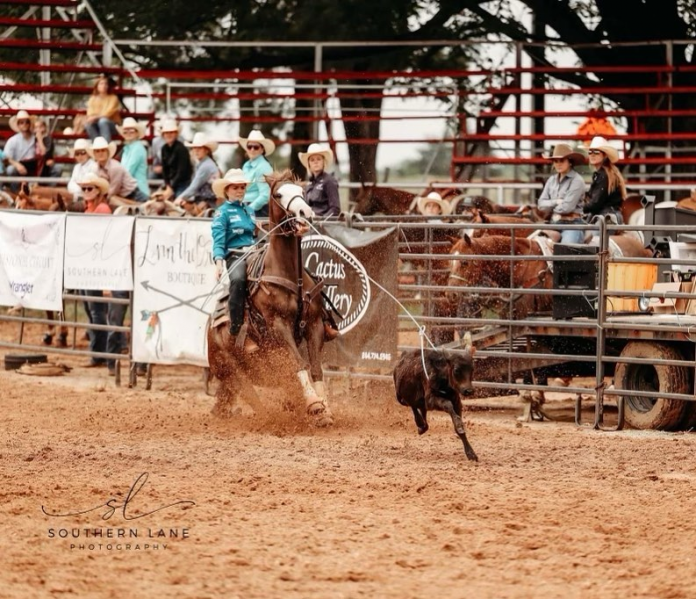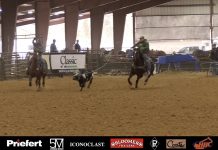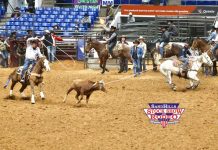Breaking it down by Speed Williams – September 2024
In all the years I’ve been going to rodeos, since I was 13 or 14, there hasn’t been many times I was the one who did most of the driving. But I was “summoned” by my girls to go with them for a week because they had quite a few all-night drives ahead of them. I tried to do most of the driving since Jennifer has been hauling Hali all summer.
Our first trip was leaving the house on August 10th and we drove to Lovington, NM. Hali had flown down with Jill, and we weren’t sure we would make it to Caldwell ID for them to rope at 5:00 the next afternoon. We made it with just 15 minutes to spare, so I’m glad she flew so she could be ready to rope.
Hali has learned to enter with just a few hours between rodeos. We left Gooding and drove to Burley, ID that night and then to Moses Lake, WA the next morning. Then to Canby, OR that night and Tremonton, UT the next day. There were only a few hours on the ground at the rodeos with a lot of driving in between.
Hali was 1.9 at the one-head rodeo in Gooding, ID. There were three 2.0 runs, and five 2.1 runs. Hali won $6,275 for first; the 2.0’s won $4,078 each; the five 2.1’s won $1,621 each and the three 2.2’s won $784. With 100 girls entered, it can be difficult for everything to line up perfectly.
While I was warming up Hali’s horses, I had a few conversations with some of the breakaway ropers. I was asked my opinion on the difference between breakaway, heading and calf roping. I said the breakaway is more difficult because there is so little margin of error. One or two tenths of a second can make such a big difference in the payout. Calf ropers usually run all the way to the calf and set things up to get a good go, get him on his feet, turn him around and be able to make a good tie. They don’t have to ping the barrier and be throwing their rope coming across the line. As in Gooding, there are a lot of rodeos where 2 tenths of a second makes a huge difference for breakaway ropers.
Most people don’t realize how important it is in breakaway for the calf to keep running. If he’s roped around the neck and checks off, it can be three to four tenths of a second before the rope pops off the saddle horn. That makes a huge difference in an event where that can be the difference in a good paycheck and not placing at all.
Before the rodeo started in Nampa, we went to a jackpot where they had walking fresh calves. Hali rode her new horse, Chester, in the first two rounds. She entered twice and in the first four calves she had one that ran and three that were just good fresh walking calves. On the run where she had to rope for the round, she rode Redlight. When she roped the calf, Redlight didn’t stop, and she had to pull with two hands to get him to stop.
Very unusual for this horse. When the horseshoer came the next day, he didn’t want to stand on his left leg. When I was rodeoing, I sometimes took my horses to Billy and Stuart at the vet clinic near the Nampa arena. Stuart has since retired and Billy was out of town, but Dr. Kevin was able to get us in that day.
They trot him on asphalt and he’s limping a grade 4 out of 5. Hali and I are thinking he’s going to be done for a few months. But when they trot on dirt, he limps at a 1 out of 5. I told her that meant it’s not a ligament or tendon so it’s probably a bruise or abscess.
They block his foot and when he trots, he’s just a hair off on hard ground. When the vet was testing his blocks and stuck him on the right side of his foot, puss and blood came out of the coronet band. That was the best-case scenario. Viper used to get abscesses often and would be dead lame. Sometimes it can take months for the abscess to bust. We were very fortunate that was all there was to it.
That week Hali drew a lot of calves that checked off, slowed up, stepped left or would run hard and when she roped them, they checked off. I’ve bought 20 head of 375 to 400 lb. calves and will sort ten for breakaway and ten for team roping. Within six to ten runs in breakaway, some calves will start checking off and changing directions. We can team rope them, and they will go back to running. The stock contractors at the rodeos have trouble keeping calves running with so many entries. It’s hard for the contractors to keep an even set. It’s the same with team roping. It’s a nightmare to get animals that are even and maintain them. Calves are not all the same and when you feed 20 or 30 in a pen, some get more feed than others. That results in one of the facts of rodeo – the luck of the draw.
Hali still has some pain and problems with her foot that limits what she can do. We talked about the need to build her upper body strength to compensate for the weakness in her leg and the need to work on her balance. She protects that foot, and it has her off balance as she comes across the line which is crucial when you need to rope in the second or third jump.
Over the last month we’ve had a lot of headers at the house. Lots of drills before lunch and roping steers and video in the afternoon. We went to the All-Star finals and in the #16 and #15 they had an old USTRC barrier and steers were fresh and ran super hard. Gabe got his first dose of running wide open and having the steers duck left if his heeler got there first; and if he got there first, they would duck right. It showed us we have a lot to work on because that happens a lot in the Open ropings. Once the barrier was shortened to a world series start, I thought he headed good.
We have a long way to go but if he can learn to head correctly, he can control his future. While we were at the rodeos, he got a lot of comments from the guys about him heading and not heeling. The majority of headers out there were heelers to begin with. To head successfully at the rodeos, it takes horsepower, understanding the different set ups, and keeping your horses working. We’ll see how he progresses and whether he chooses to head or heel.
I was also asked what I was going to do when Gabe turns 18. I quit rodeoing to raise my kids and help them with their life choices. I’m fortunate they chose roping because it’s something I understand and know what they need to learn to be able to succeed. I never made them rope; however, I would bribe them with rewards for catching. The rewards usually consisted of a movie, where we ate dinner, or any activity they wanted to do.
Yesterday my girls had a scary incident happen to them while driving to Hermiston, OR. If this would have happened in a more mountainous area, I’m not sure they would be here today. While driving they blew a belt off the Ford truck, losing their power steering and brakes. The truck kept running so they had trailer brakes to stop the rig. Jennifer said it was like driving an old tractor without power steering. Last night I had a few nightmares where I drove off a cliff. I promise we’re going to start changing the belts regularly. Another thing to consider if you travel a lot is changing your wheel bearings when you get the chance. It doesn’t cost that much and when they go out, you’re stranded.





What is the best way to talk to you personally?
I sent you an email justaroper@gmail.com plus my cell